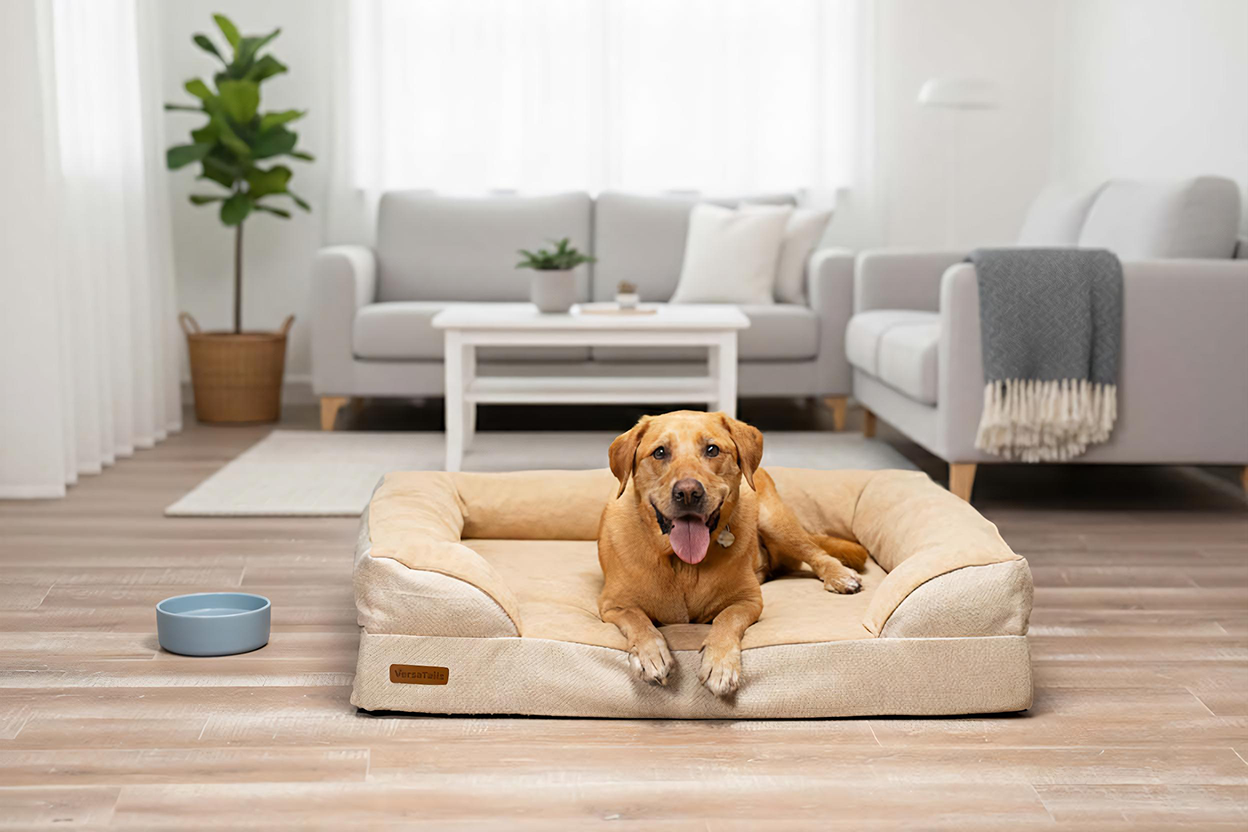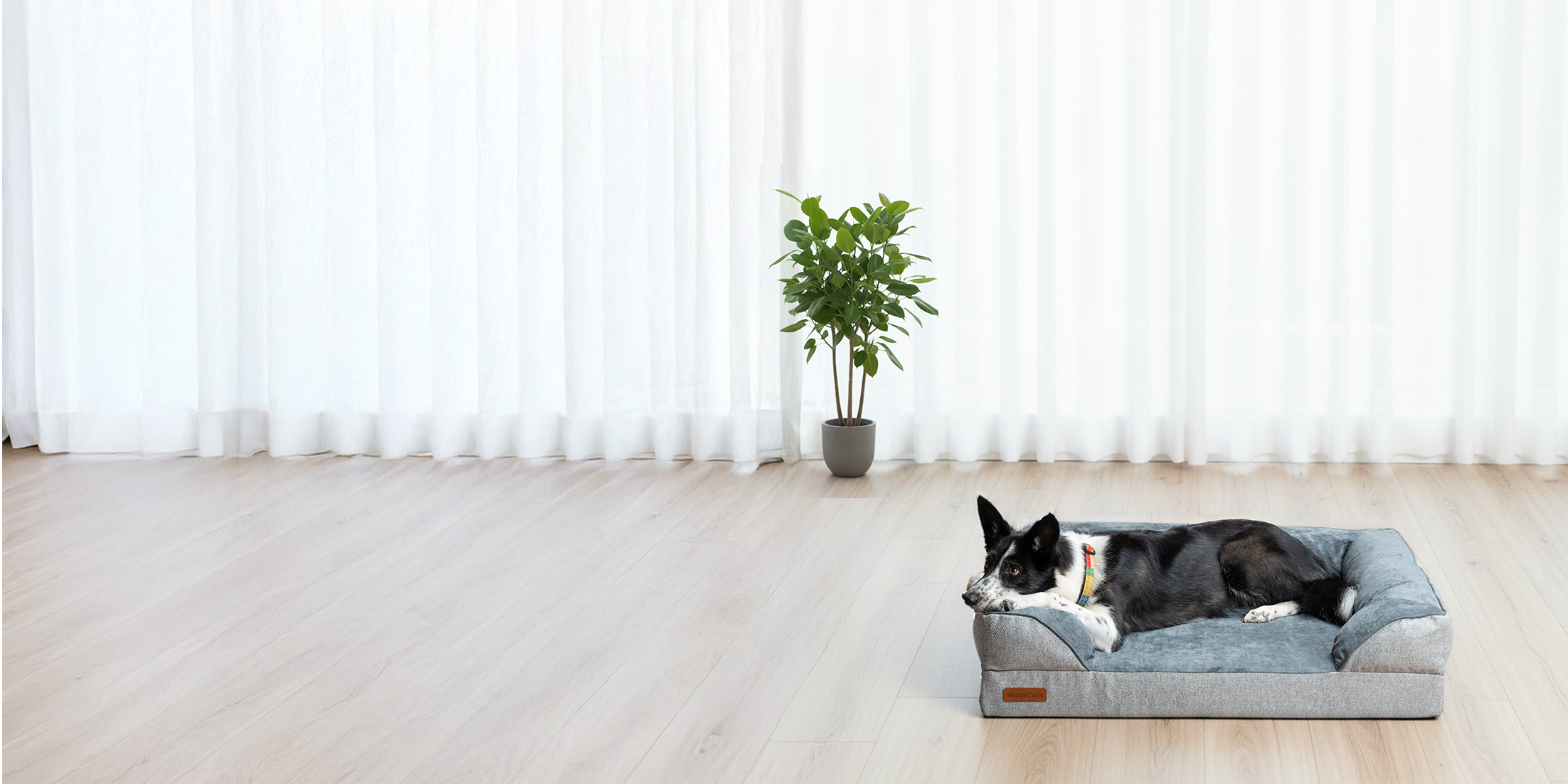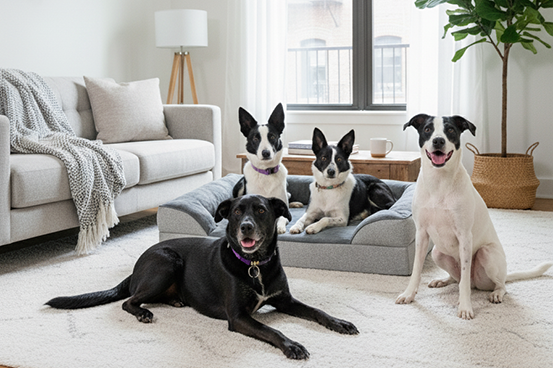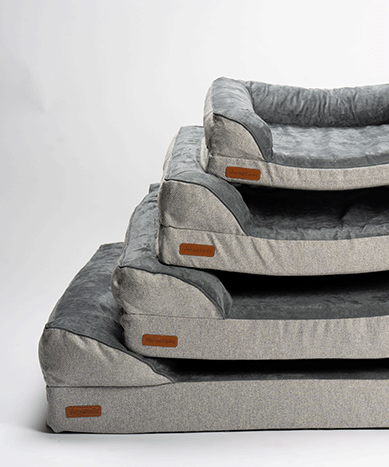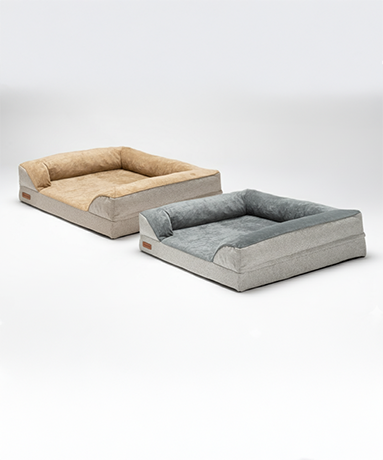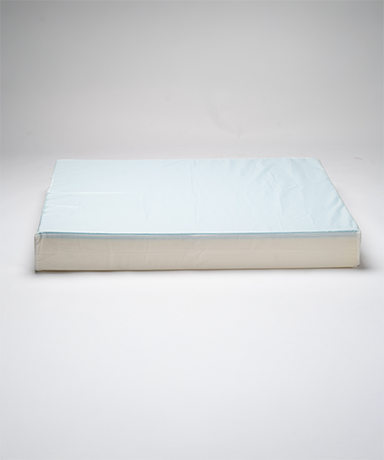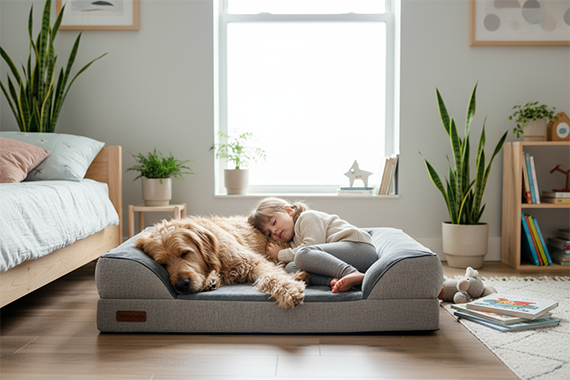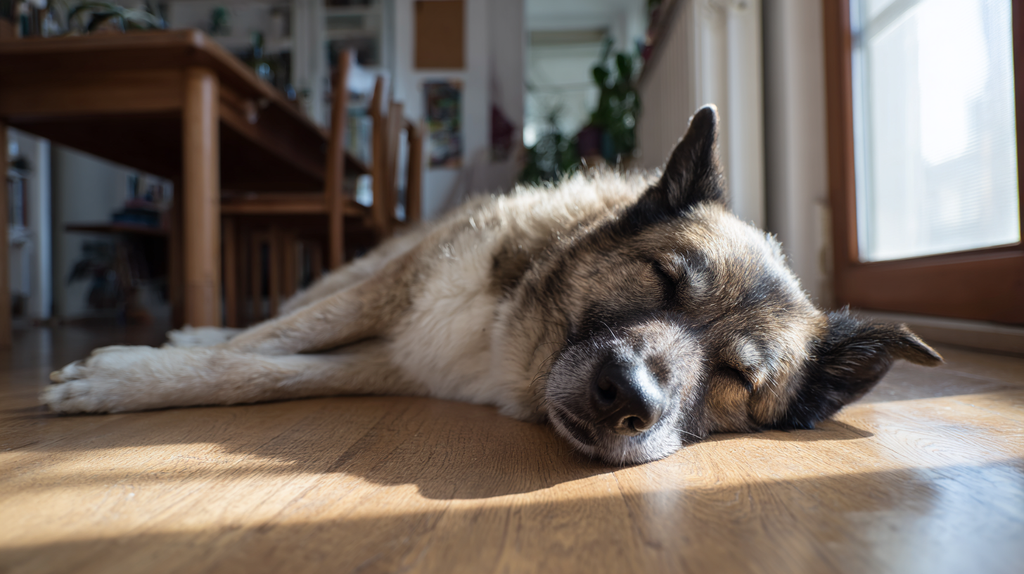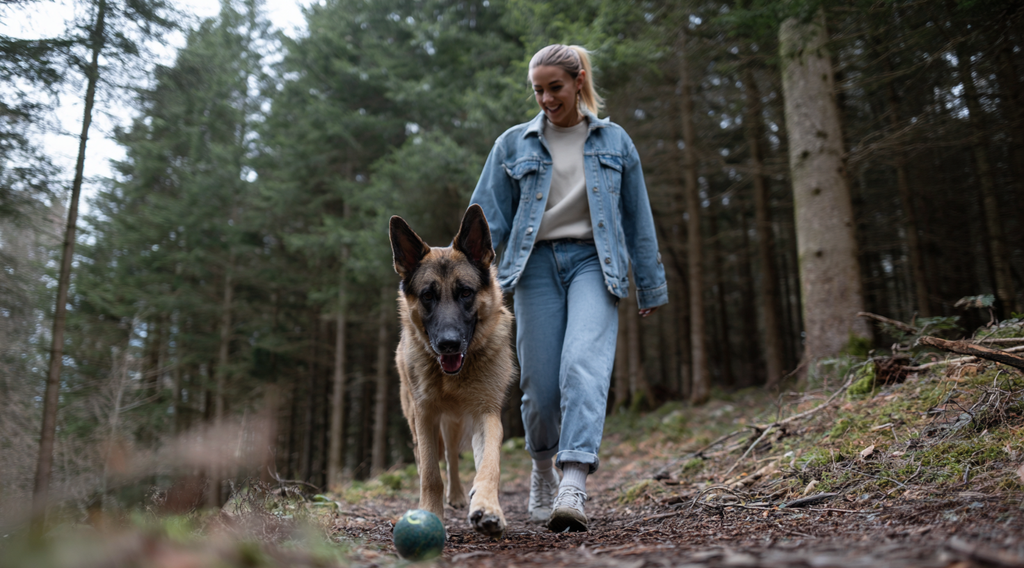What makes the VersaTails bed truly "orthopedic״?
Approved by Picky Sleepers
VersaTails™ Human-Grade Dog Bed
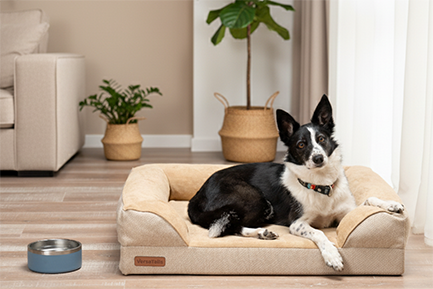
Furniture-Grade Fabrics
TripleEase™ System
Certified Quality
Truly Washable
What Vets are Saying
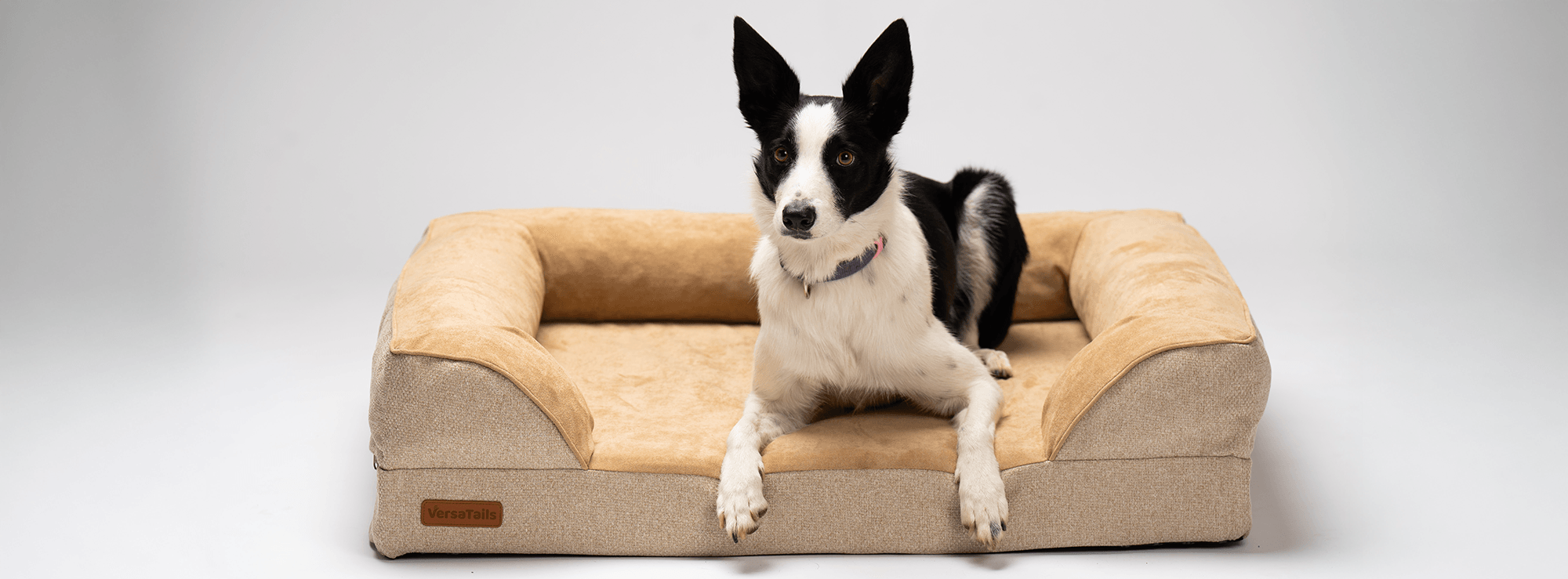
Frequently Asked Questions
Engineered for Wellness
Most Popular Blog Posts
As pet parents ourselves, we know how easy it is to notice the little changes in your dog’s daily routine. Maybe walks have gotten slower, or your pup hesitates before climbing onto the couch. These small shifts can feel worrying, and often they’re among the first signs of arthritis.
When Little Changes Point to Bigger Joint Problems
It’s never easy to think about your dog being in pain. We’ve been there too, and we understand how helpless it feels when they limp after a nap or seem stiff when standing. The good news is that when arthritis is caught early, there’s so much you can do to ease discomfort and protect your dog’s mobility for the future.
What Are the First Signs of Arthritis in Dogs?
The earliest signs often slip under the radar. You may notice:
-
Walks becoming slower, even when your dog seems eager
-
Reluctance to climb stairs, jump into the car, or hop on the bed
-
Stiffness or limping after rest that improves as they move
-
More naps or a reduced interest in play
-
Subtle changes in posture or gait
Arthritis isn’t only a senior dog issue. Breeds like Golden Retrievers, Labradors, and German Shepherds can develop joint problems earlier than expected. Recognizing these early signs gives you the chance to take proactive steps before things worsen.
Which breeds are most at risk for arthritis?
Some dogs simply face joint challenges more often than others. Large, active breeds such as Labradors, Golden Retrievers, and German Shepherds are particularly vulnerable, thanks to the extra weight and wear on their hips and elbows.
 Short-legged breeds like Dachshunds, Bulldogs, and Corgis also face higher risk due to their body structure. And it’s not just individual dogs, it’s a widespread issue: in the United States, about 20% to 25% of dogs are estimated to suffer from arthritis at some point in their lives. Recognizing these risk factors early and giving your dog a supportive orthopedic bed, along with weight management and gentle joint-friendly care, helps protect their mobility and happiness well into their golden years.
Short-legged breeds like Dachshunds, Bulldogs, and Corgis also face higher risk due to their body structure. And it’s not just individual dogs, it’s a widespread issue: in the United States, about 20% to 25% of dogs are estimated to suffer from arthritis at some point in their lives. Recognizing these risk factors early and giving your dog a supportive orthopedic bed, along with weight management and gentle joint-friendly care, helps protect their mobility and happiness well into their golden years.
Why Does My Dog Hesitate to Jump or Climb Stairs?
Dogs with arthritis often avoid movements that put pressure on sore joints. If your pup pauses at the bottom of the stairs, it’s a sign those movements are painful.
What helps is reducing the strain. Using ramps, keeping furniture accessible, and choosing a low-entry orthopedic bed can all make daily life more comfortable.
How Do We Support a Senior Dog with Arthritis at Home?
Caring for a dog with arthritis means making thoughtful adjustments. Here’s what works:
-
Gentle, regular exercise to keep muscles strong
-
Low-impact activities like swimming when possible
-
Careful weight management to reduce joint pressure
-
Orthopedic rest surfaces for pain-free sleep
-
Vet-approved supplements for joint health
-
Routine vet visits to adjust care as needs change
Together, these small steps can transform your dog’s quality of life, giving them more ease and more good days.
Which Dog Bed Is Best for Senior Dogs with Joint Pain?
Senior dogs need a bed that balances comfort with practicality. Look for:
-
Foams that resist flattening, ensuring long-lasting support
-
Low, open entry to prevent painful climbing
-
Structured bolsters for stability and comfort
These details aren’t just conveniences, they’re ways to help your dog feel safe, supported, and dignified as they age.

What Is the Best Dog Bed for Arthritis?
For a dog with arthritis, a bed isn’t just for sleeping, it’s a recovery space. The best dog bed for arthritis should:
-
Relieve pressure points with multi-layer orthopedic foam
-
Regulate temperature with a cooling gel top layer
-
Provide low-step access so stiff joints aren’t stressed
-
Include bolsters for leaning and spine support
-
Stay hygienic, with waterproof liners and washable covers
Veterinarians recommend orthopedic beds. That’s why we built the VersaTails orthopedic bed with triple-layer foam, hypoallergenic certified fabrics, and a low-entry bolster design, because comfort and health should go hand in hand.
Why Early Care Makes All the Difference
Arthritis doesn’t have to mean the end of play, walks, or happy routines. By noticing early signs and making proactive choices, you can give your dog comfort and mobility at every stage of life.
If you’re looking for the best dog bed for arthritis, explore options designed with real joint care in mind. At VersaTails, our orthopedic dog bed is crafted with human-grade foam, certified-safe fabrics, and vet-recommended design features, because your dog deserves the same comfort you expect for yourself.
FAQs
What are the early signs of arthritis in dogs?
Early signs often show up as stiffness after resting, limping, slower walks, or reluctance to jump and climb stairs. You may also notice changes in posture, less interest in play, or more frequent naps. Catching these small changes early can help you take steps that ease discomfort before the pain worsens.
Which breeds are most at risk for arthritis?
Large breeds like Labradors, Golden Retrievers, and German Shepherds are highly prone to arthritis. Short-legged breeds such as Dachshunds and Bulldogs are also at risk because of their body structure. Even younger dogs of these breeds can develop joint problems, so being proactive matters.
Does weather make arthritis in dogs worse?
Yes. Cold or damp weather can increase stiffness and make joint pain feel worse for many dogs. You might notice your pup moving more slowly or seeming reluctant to go outside when the temperature drops. Providing a warm, supportive bed indoors can make a big difference.
What type of dog bed helps with arthritis pain?
Orthopedic dog beds with multi-layer foam are best for arthritis relief. A cooling gel layer helps regulate temperature, while supportive memory foam reduces pressure on sore joints. Low-step entry and bolstered sides make it easier for your dog to climb in and rest comfortably.
How can I support my dog’s joints at home?
Gentle exercise, maintaining a healthy weight, and providing a supportive orthopedic bed all help ease joint strain. Supplements recommended by your vet, along with small changes like using ramps or non-slip rugs, can improve mobility and make daily life more comfortable for your dog.
Nothing beats a quick check with your vet.
At VersaTails, we share insights to help you care for those who matter most. Still, this blog is not medical advice. Every dog is different, and their health deserves personal attention. If you ever feel something isn’t quite right with your pup, always check in with your veterinarian, they’re your best partner in keeping tails wagging.
Pet parents often wonder how to know if my dog sleeps well. Dogs, like people, rely on quality sleep to restore energy, regulate mood, and support long-term health. Poor rest can show up in subtle ways such as stiffness, restlessness, or frequent position changes. Recognizing these early helps you take action to improve your dog’s comfort and wellness.
How to Know If My Dog Sleeps Well?
A dog sleeps well if they wake up calm, stretch easily, and show steady energy throughout the day.
Dogs that wake up stiff, sluggish, or nap excessively may not be getting restorative rest. Tracking daily patterns and morning behavior is one of the best ways to assess sleep quality.

What Are the Signs of Poor Rest in Dogs?
Restlessness During the Night
Frequent pacing, circling, or getting up during the night is a common sign of discomfort.
While occasional restlessness is normal, repeated interruptions suggest that the sleep surface or environment is preventing deep rest.
Frequent Position Changes
Dogs that constantly switch positions may be trying to ease joint pressure or regulate body temperature.
Quality rest usually means settling into one or two positions for longer stretches.
Morning Stiffness or Difficulty Rising
Stiffness, limping, or hesitation when rising in the morning indicates poor rest quality.
These signs are especially common in large breeds and senior dogs, and they may worsen if left unaddressed.
Do Dogs With Joint Pain Struggle to Sleep?
Yes. Dogs with arthritis or joint pain often wake up sore or restless because they can’t fully relax during sleep.
Without proper support, discomfort leads to repeated wake-ups. Proactive care, from healthy weight management to supportive rest surfaces, can reduce these problems and improve sleep cycles.
How Can I Improve My Dog’s Sleep Quality?
Create a Rest-Friendly Environment
Place the bed in a quiet, draft-free area and maintain a consistent bedtime routine.
Dogs settle best when their sleeping spot feels safe, predictable, and undisturbed.
Support Physical Comfort
Balanced exercise, healthy weight, and vet-approved joint support all reduce stress on the body. Small changes in daily care can make it easier for your dog to relax and stay asleep.
Observe and Adjust
Track your dog’s sleep for several days to spot patterns of restlessness, stiffness, or disrupted naps.
If issues persist, consider a change in sleeping arrangements or a veterinary consultation.
When Should I See a Veterinarian?
Always consult your veterinarian if you think something isn’t right. If poor sleep continues and is paired with stiffness, limping, or changes in mobility, a professional exam can rule out underlying conditions and ensure your dog receives the right care.
When your dog rests well, everything else gets better
Recognizing dog rest quality signs, such as restlessness, frequent repositioning, or morning stiffness, gives you the tools to improve your dog’s comfort before problems escalate. Quality rest is not a luxury; it’s a foundation for long-term health.
For many dogs, upgrading their sleep surface is part of the solution. An orthopedic dog bed that offers layered support and easy access, can reduce restlessness and stiffness, helping your pup sleep more soundly.
Learn more about supportive rest solutions like the VersaTails Orthopedic Dog Bed.
Nothing beats a quick check with your vet.
At VersaTails, we share insights to help you care for those who matter most. Still, this blog is not medical advice. Every dog is different, and their health deserves personal attention. If you ever feel something isn’t quite right with your pup, always check in with your veterinarian — they’re your best partner in keeping tails wagging.
If you share your life with a large-breed dog, you’ve probably worried about their hips and joints. Maybe you’ve seen a friend’s Labrador start to limp at just six years old, or you’ve heard about Golden Retrievers developing arthritis. We know that fear, it’s the reason so many of us look for ways to protect our dogs before the first signs of stiffness appear.
The truth is, hip dysplasia and arthritis don’t have to feel inevitable. With the right diet, proactive care, and a supportive sleeping surface, you can dramatically reduce the strain on your dog’s joints. Prevention means more years of pain-free play, comfortable naps, and long walks together.
Why Prevention Matters for Dog Joint Health
Joint disease creeps in quietly. It often starts with something small, hesitating before climbing stairs, struggling to get up after a nap, or refusing to jump into the car. By the time these signs show, damage has already begun.
That’s why acting early is so important. Helping your dog maintain a healthy weight, feeding a diet that supports joint health, and giving them a bed designed for orthopedic support are simple steps that protect their joints before wear and tear sets in.

5 Dog Joint Health Tips Every Pet Parent Should Know
1. Keep Your Dog at a Healthy Weight
If your dog is carrying extra pounds, every step puts unnecessary pressure on their hips and knees. For large breeds, even a small weight gain can accelerate arthritis. Sticking to measured portions, choosing nutrient-rich food, and staying active together will protect their joints more than any supplement ever could.
2. Choose the Right Diet
Dogs can’t tell you when their joints feel sore, but you can feed them in a way that supports joint health. Diets with omega-3 fatty acids reduce inflammation, while glucosamine and chondroitin nourish cartilage. If you’re unsure where to start, ask your vet whether a supplement is right for your dog’s breed and age.
3. Invest in Supportive Sleep Surfaces
Your dog spends most of their day resting. If that rest is on a thin, worn-out bed, their joints never get a break. Orthopedic foam cushions pressure points, helping large breeds avoid hip and elbow issues. It’s a quiet, powerful form of prevention that works while your dog sleeps.
4. Encourage Low-Impact Exercise
I know it’s tempting to let your dog chase the ball until they collapse, but high-impact exercise can be tough on growing or aging joints. Swimming, controlled walks, and gentle play build strength without the wear and tear.
5. Schedule Regular Vet Check-ups
Even if your dog seems fine, yearly exams help catch stiffness or changes in mobility early. Think of it as “joint insurance”, you’d rather hear “everything looks great” than wait until the damage is visible.

Which Dog Bed Helps with Joint Pain?
Dogs already experiencing joint pain need a bed that cushions, supports, and protects.
If your senior dog struggles to get comfortable or whimpers when standing up, their bed may be part of the problem. Orthopedic beds with certified orthopedic foams mold to the body but stay firm enough to support aching joints. Look for features like a waterproof liner (for accidents) and removable covers (for easy cleaning). Certifications such as CertiPUR-US® and OEKO-TEX® guarantee that the materials touching your dog are safe for sensitive skin.
What Is the Best Orthopedic Dog Bed for Large Breeds?
The best orthopedic dog bed for large breeds is one that relieves pressure points, stays supportive over time, and makes it easy for your dog to climb in and out.
If you’ve ever seen your dog toss and turn on a flattened bed, you know how uncomfortable it can be. Large dogs need more than just padding. They need layers of memory foam and supportive base foam that distribute weight evenly, protect hips and elbows, and prevent sagging. Bolstered edges give them a place to lean or rest their head, while a low step entry saves their joints from extra strain.
This isn’t about luxury, it’s about protecting your dog’s mobility for years to come. A high-quality orthopedic bed becomes part of your prevention plan, not just a nap spot.
Can the Right Bed Prevent Arthritis in Dogs?
Starting early with an orthopedic bed helps reduce stress on growing joints and may delay the onset of arthritis.
Think of it like this: you wouldn’t let your child sleep on the floor every night. Giving your dog proper joint support from puppyhood protects them from the micro-damage that leads to arthritis later in life. Many proactive pet parents are choosing orthopedic beds for their young Labradors, Goldens, and German Shepherds, not because their dogs are hurting now, but because they want to keep them moving comfortably for the long haul.
Key Takeaways for Your Dog’s Joint Health
Preventing joint problems isn’t about reacting when it’s too late. It’s about being proactive now, feeding the right diet, encouraging safe exercise, and making sure your dog’s body rests on a surface that actually supports them.
If you’re looking for the best orthopedic dog bed for large breeds, choose one that’s vet-approved, built with multi-layer foam, and made from human-grade materials. It’s one of the simplest and most effective ways to give your dog a healthier, more comfortable future.
Your dog counts on you for every step they take. Give them the comfort and protection their joints deserve. Explore the VersaTails Orthopedic Dog Bed, crafted like a premium human mattress and recommended by veterinarians for lasting joint support.
FAQs
How can I tell if my dog has arthritis or joint issues?
Watch for gradual changes like stiffness when getting up, resistance to stairs, limping that comes and goes, and decreased interest in play. Early detection helps with better outcomes.
At what age do dogs typically develop arthritis or hip problems?
While most dogs show signs by age eight, large breeds may exhibit symptoms as early as one year. Genetics, growth rate, and weight all influence timing.
Can using an orthopedic dog bed actually help prevent arthritis?
Though it isn’t a cure, a high‑quality orthopedic bed reduces pressure on joints and supports better alignment. Starting early, especially for breeds genetically prone to hip issues, may delay symptom onset.
What defines an orthopedic dog bed and when is one necessary?
Orthopedic beds use dense foam (often memory foam) to relieve pressure. They're especially helpful for dogs with joint pain, senior dogs, or breeds prone to hip dysplasia, but any dog can benefit from better support.
How quickly do arthritis and hip dysplasia develop?
These conditions progress gradually. With hip dysplasia, immature joints and rapid weight can contribute early, while arthritis often develops over years. Proactive care helps slow progression.
Nothing beats a quick check with your vet.
At VersaTails, we share insights to help you care for those who matter most. Still, this blog is not medical advice. Every dog is different, and their health deserves personal attention. If you ever feel something isn’t quite right with your pup, always check in with your veterinarian, they’re your best partner in keeping tails wagging.
